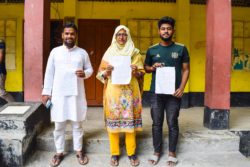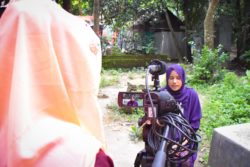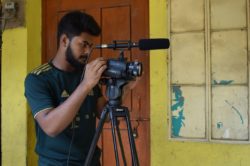Articulating PV into the Community Dialogue Approach: Reflections
What is Participatory Video (PV)?

PV is a process where researchers and members of a community come together to produce films. PV has been used in very many contexts around the world. In terms of Public Health research, a typical model is for researchers to approach a community with the idea of producing films on a particular health issue then support community members through the process of exploring both the health issue and filmmaking process with the aim of, for example, creating public health resources or helping a community to advocate for policy change with local, regional or national policymakers.
The films produced can provide insights into community behaviours; in the case of COSTAR community members have explored local drivers of AMR, identifying potential challenges and opportunities to address AMR locally, creating films that relate to the experiences of their own communities. The messages included in films are locally appropriate (for example, a person viewing films might not be from that exact district but can see that it has been filmed in a similar district to their own by people who have similar lifestyles) Films can also be used as a way to ‘speak truth to power’ by showing films to local and national policy makers. The films document local experiences needs & hopes from their own perspectives and provide policy makers, public health organisations and researchers with insights they might not have otherwise.
At the core of PV is an idea of ‘co-production’ where researchers and community members generate knowledge together. Researchers bring their ‘expert knowledge’ of filmmaking and health issues. Community members bring their ‘expert knowledge’ on local practices attitudes and behaviours. By binging that knowledge together, the group decides on the best way to make and share films and who needs to see them.
What is the ‘Community Dialogues Approach’?

For the COSTAR project we are looking at how PV might be incorporated into a bigger health intervention – Community Dialogues. Malaria Consortium, a partner in the COSTAR project has pioneered the Community Dialogues Approach: “The Community Dialogue Approach was developed by Malaria Consortium and is based on the Integrated Model of Communication for Social Change (IMCFSC) where an iterative process of community dialogue and collective action work together to produce social change in a community that improves the health and welfare of all of its members. Community-based volunteers are training to facilitate regular community meetings where specific health issue affecting the community are explored, local solutions are identified, and participants collectively decide and plan how best to address the chosen issue. The approach is embedded within existing community and health structures, allowing for social accountability and technical oversight. It is designed to empower individuals, and over time strengthen the relationship between communities and health service providers.”
To read more on this and other work, visit Malaria Consortium.
How is PV being used in the COSTAR project?
 Researchers in Bangladesh (in the ARK team) have already conducted some PV workshops and are in the process of putting together films made by people in the community. Below is a reflection from Meahadi Islam Shuvo (a Documentation Officer at the ARK Foundation, Bangladesh who has led this process) on the first round of PV workshops in Bangladesh:
Researchers in Bangladesh (in the ARK team) have already conducted some PV workshops and are in the process of putting together films made by people in the community. Below is a reflection from Meahadi Islam Shuvo (a Documentation Officer at the ARK Foundation, Bangladesh who has led this process) on the first round of PV workshops in Bangladesh:
The workshop was designed in such a way that even individuals who had no prior knowledge of anti-microbial resistance, medicine, or video production could eventually come up with a firm understanding of the subjects and the ability to produce participatory videos. They were provided with camera sets to familiarize them with the various aspects of this device. They took photographs of themselves, created videos of random objects, communicated with one another to come up with new ideas, and conducted interviews among themselves. They just used the camera sets without any purpose, but by engaging in the aforementioned activities, they became competent in using them. Once they had mastered the basics of operating the camera, they proceeded to learn about other aspects of video production, such as how to conduct effective interviews and how to accurately portray the people in the videos. In addition, it was standard practice for the facilitators to analyse and monitor the participants during the entire procedure. The facilitators also regularly evaluated the participant’s performance during activities, which helped the learners to assess their own progression. They were also instructed on ways to improve the overall quality of the videos they produced. They got an understanding of certain important factors to keep in mind when producing videos. These concerns included aspects such as colour, lighting, aperture, framing, set and operating devices, and so on.
Why do we want to articulate PV into Community Dialogues?
The content of community dialogues (CD) sessions must be carefully planned and all messages must be concise and contextually appropriate. Additionally, given the potential number of AMR-related messages that could be included in CDs, messages must be first identified then prioritised in accordance with the local context. Messages should be relevant and acceptable to the community where the dialogues are to take place. It was felt that videos, made by local community members, could provide valuable insights into which messages to prioritise.
In order to plan an effective Community Dialogues project, first we need to identify and define local issues in relation to AMR; what are the drivers at the local level? Is there a need for change? What are the barriers and opportunities for change? PV can be a tool for understanding these points within a community. Films are designed by and for community members and often present local attitudes and practices in relation to antimicrobials. PV can begin discussions with members of a community and provide insights into local practices. These insights can be shared directly through plots, narrative and scripts but also indirectly through sub-texts (implied messages) and through the choices made in shooting, casting of films etc. Participants in PV workshops often decide to showcase films with local stakeholders (community members, policy makers etc). In these showcasing environments, researchers can gain an understanding of how accurately the films produced reflect the lived experiences of those in that community and how they are received by that community.
What’s the value of articulation?

PV has not yet been articulated into a larger health intervention. We want to explore the value of PV in this wider context, rather than as a stand-alone project or one used to produce educational videos only. Throughout the COSTAR project, we want to identify where PV outputs may be useful in shaping other elements of the intervention. This must be undertaken while also appreciating PV outputs as creative resources owned by participants and their communities.
Participants in a PV project are encouraged to share their experiences, opinions and suggestions through creative means. Filmmaking can empower members of a community to share honestly and openly their views on local issues, often in a way that may be difficult using more traditional research design. Interviews, for example, are often shaped by the researchers where videos are shaped by participants. As Shuvo reflects:
The participants had a great deal of creative potential. They came up with many interesting and constructive ideas for the scripts. As a result of actually working on the set, participants did not stop coming up with more innovative thoughts, lines of dialogue, and contextualizing details that give the scenes more spirit. Their insightful criticisms contributed to making the videos more realistic and contextual because of their greater familiarity with the local culture, language, and surrounding environment.
This creativity, generated through PV workshops, can be used to shape intervention materials. As noted by Shuvo, in his experience participants felt comfortable in ensuring the accuracy of messages within films; accuracy, here, relating more to locally realistic stories rather than the medical accuracy of messages.
In the COSTAR project, we hope to explore the potential use of the videos produced as creative story-telling tools and trigger-points for discussion during the planning and delivery stages of the CDs.
